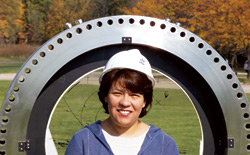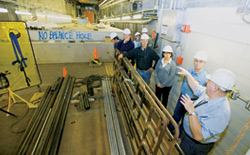Essay: Emily Saltijeral-Demar
 |
 |
| Photos courtesy of Emily Saltijeral-DeMar |
An in-depth look at a deep place
Our tour guide encouraged us to look at our destination, the NuMI tunnel, some 300 feet below. Standing next to the rail, one hand holding my hard hat in place and the other keeping my glasses from flying off, I looked down into what seemed to be a bottomless pit. My colleagues, several with physics or engineering backgrounds, appeared excited about getting down there. I didnt share their excitement. Tunnels and confined spaces have always made me uncomfortable. However, many months earlier, I had volunteered to serve on the Fermilab ILC Citizens Task Force. Now it was time to stifle my anxieties and get on with business.
The ILC Citizens Task Force had been formed to solicit community response and input into the planned bid to bring the International Linear Collider to Fermilab. Our membership included a broad spectrum of backgrounds: physicists and engineers, business people and professionals, local politicians, public servants, and retirees. We brought to the table many perspectives, opinions, and issues. However, in my mind there were two elements we all shared: One was a belief that getting the ILC sited at Fermilab was of critical importance to the entire region. The other was that Fermilab would need to work very closely and cooperatively with all the communities potentially affected by the construction. The last thing anyone wanted was a repeat of the friction between the lab and local community groups during planning for the ill-fated Superconducting Super Collider in the late 1980s.
For the past seven months, task force members had come to the lab for regular briefings on various aspects of building the ILC. We listened to detailed presentations on the ILC global design effort, potential layouts for the collider on the Fermilab grounds, environmental concerns, construction-related issues, economic aspects, community relations, and safety. All were accompanied by frank and open discussions.
For a non-technical person like myself, the briefings had been a little bewildering. While I was able to assemble pieces of the puzzle, the big picture was still fuzzy. Then someone proposed that we take a tour of NuMI, or Neutrinos to the Main Injector, a 4000-foot-long tunnel where beams of neutrinos are generated—and a reasonably close representation of what ILC construction might look like. As a result, I found myself somewhat reluctantly waiting for that elevator down to NuMI hall.
The elevator ride was bumpy and slow, and when the door finally opened I was in a place much different than I expected. It reminded me a bit of the Bat Cave. As we walked, I learned how structured the process of digging such a tunnel would be, and how concrete would literally be sprayed on the walls to seal them. Yes, blasting would be required, but it should be imperceptible to anyone up on the surface, and would be scheduled at minimally disruptive times. The speed at which the tunnel would be dug—about 300 feet per day—was astounding. One of the more amusing tidbits was that the debris from the NuMI excavation had been reused and distributed throughout the site. Imagine that—recycling earth. The safety features were obvious and numerous. In typical Fermi-fashion, no one was getting into that tunnel without first receiving thorough instruction from a safety officer. By the time our tour finished, I had gained a much better understanding of what the construction of an ILC tunnel would actually entail. I also left my fear of tunnels behind.
Returning to the surface, we broke into a pastoral setting on a beautiful fall day. Bicyclists pedaled by and waved at us. We waved back, hard hats and all. I doubt that those bicyclists had any idea of the wonderful, complex physics research being conducted right below them. All they probably knew was that they were enjoying a peaceful ride in a really neat place. In a larger sense, thats the model the ILC seeks to follow, pushing the envelope of scientific research to the limit while quietly blending in as an asset to the surrounding community. I sure hope it happens here.
Emily Saltijeral-DeMar
Emily Saltijeral-DeMar lives in Aurora, Illinois, where she is a columnist for the Beacon News and writes for local Spanish language newspapers. She also serves on the Fox Valley Park District board of trustees.
Click here to download the pdf version of this article.


